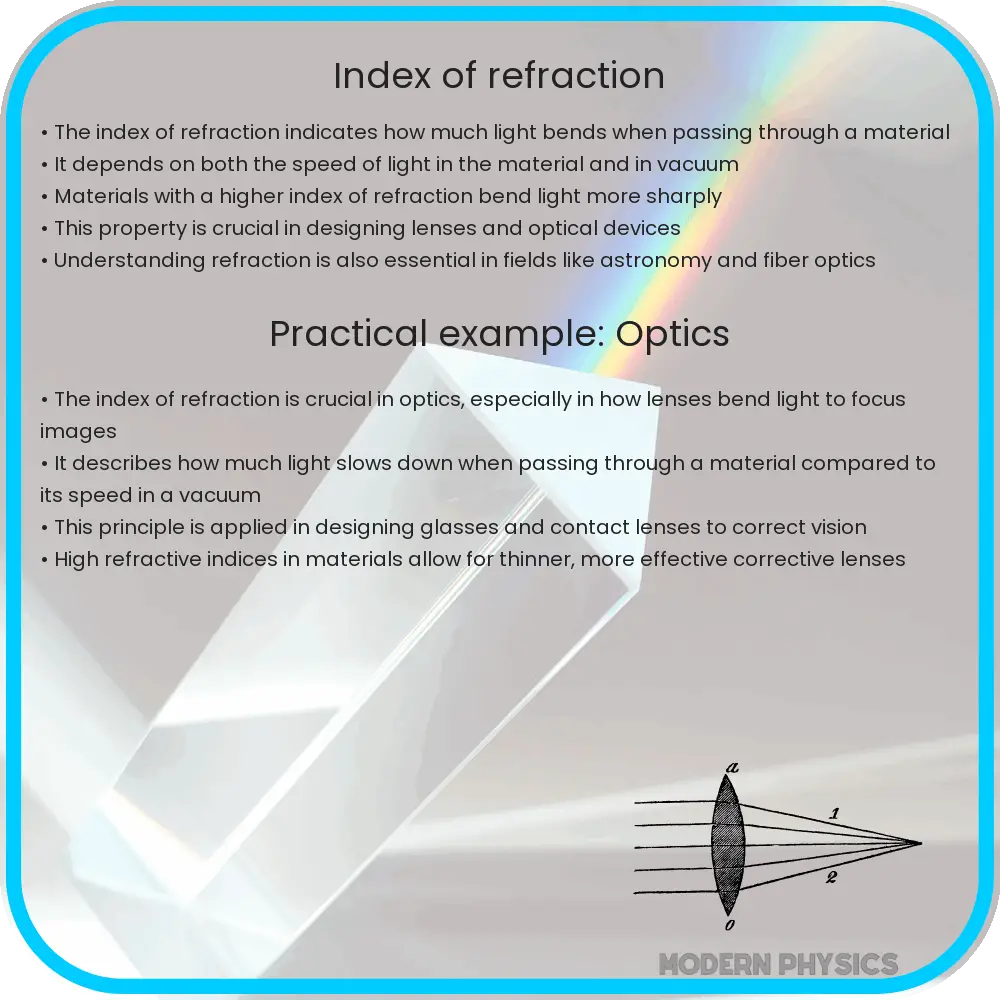Explore the index of refraction: its definition, applications in technology and nature, challenges, and future potential in optics and physics.

Understanding the Index of Refraction
The index of refraction, denoted as n, is a fundamental concept in optics and physics. It measures the extent to which light is bent, or refracted, when it passes from one medium into another. This property of materials plays a crucial role in understanding light behavior, influencing the design of lenses, prisms, and other optical devices.
Definition and Formula
The index of refraction is defined as the ratio of the speed of light in a vacuum (c ≈ 3.00 x 108 m/s) to the speed of light in the medium (v). Mathematically, it is expressed as:
n = c/v
This dimensionless number varies depending on the medium. For example, the index of refraction of air is approximately 1.0003, while water has a value of about 1.33.
Applications in Daily Life and Technology
The index of refraction is not just a theoretical concept but has practical applications in everyday life and various technologies. One of the most common applications is in the design and manufacture of corrective lenses for eyeglasses and contact lenses. By precisely controlling the refractive index of lens materials, opticians can correct vision impairments like myopia (nearsightedness) and hyperopia (farsightedness).
Another significant application is in the field of telecommunications, particularly in the use of fiber optics. Optical fibers rely on the principle of total internal reflection, which is governed by differences in refractive indices between the core and the cladding of the fiber. This allows efficient transmission of data over long distances with minimal loss.
Importance in Scientific Research
In scientific research, the index of refraction is critical in spectroscopy and various experimental techniques. It helps in identifying substances based on how they refract light and is fundamental in studies involving light-matter interactions. This property is also pivotal in the development of new materials with unique optical properties, such as metamaterials, which can bend light in unconventional ways.
Moreover, the concept of refractive index extends beyond visible light. It is relevant in studying how other forms of electromagnetic radiation, like X-rays or microwaves, interact with different materials. This broader application has implications in fields ranging from medical imaging to astronomy.
Exploring Refraction in Nature and Art
Refraction is not just limited to scientific and technological realms; it also manifests in nature and art. The beautiful phenomenon of rainbows is a classic example of refraction, dispersion, and reflection of sunlight in water droplets, showcasing the spectrum of visible light. Artists and architects often use glass and water elements to create stunning visual effects through refraction, adding a dimension of interplay between light, color, and space in their works.
Challenges and Future Directions
Despite its widespread applications, manipulating the index of refraction poses challenges. In optical engineering, creating materials with specific refractive indices while ensuring clarity and stability is complex. The ongoing research in photonics and metamaterials aims to overcome these challenges, paving the way for innovative applications such as invisibility cloaks and advanced lenses.
Future advancements in controlling and exploiting refractive indices hold the potential to revolutionize various fields. For instance, developing materials with a negative index of refraction could lead to superlenses that surpass the diffraction limit of conventional lenses, allowing for imaging at a molecular or even atomic level. Similarly, advancements in fiber optics could result in even faster and more efficient data transmission, further boosting the capabilities of global communication networks.
Conclusion
In conclusion, the index of refraction is a pivotal concept in understanding and manipulating light. From its fundamental role in optics and physics to its diverse applications in technology, art, and nature, the study and use of refractive indices continue to shape our world in myriad ways. As technology advances, the exploration of refractive properties promises to unveil new possibilities, potentially leading to groundbreaking innovations in various domains. Thus, the index of refraction, a simple ratio, holds the key to unlocking a future where the manipulation of light could redefine our perception and interaction with the world around us.
